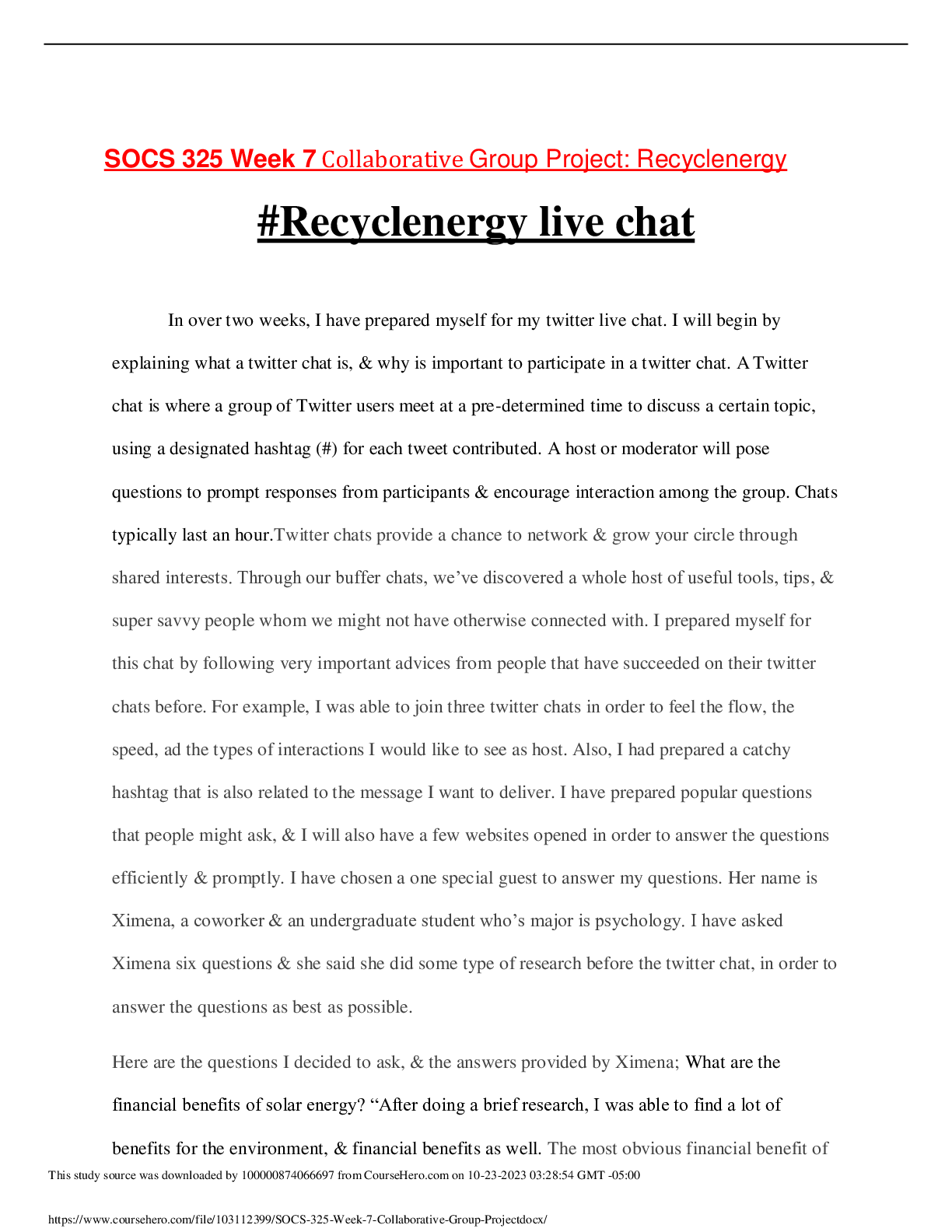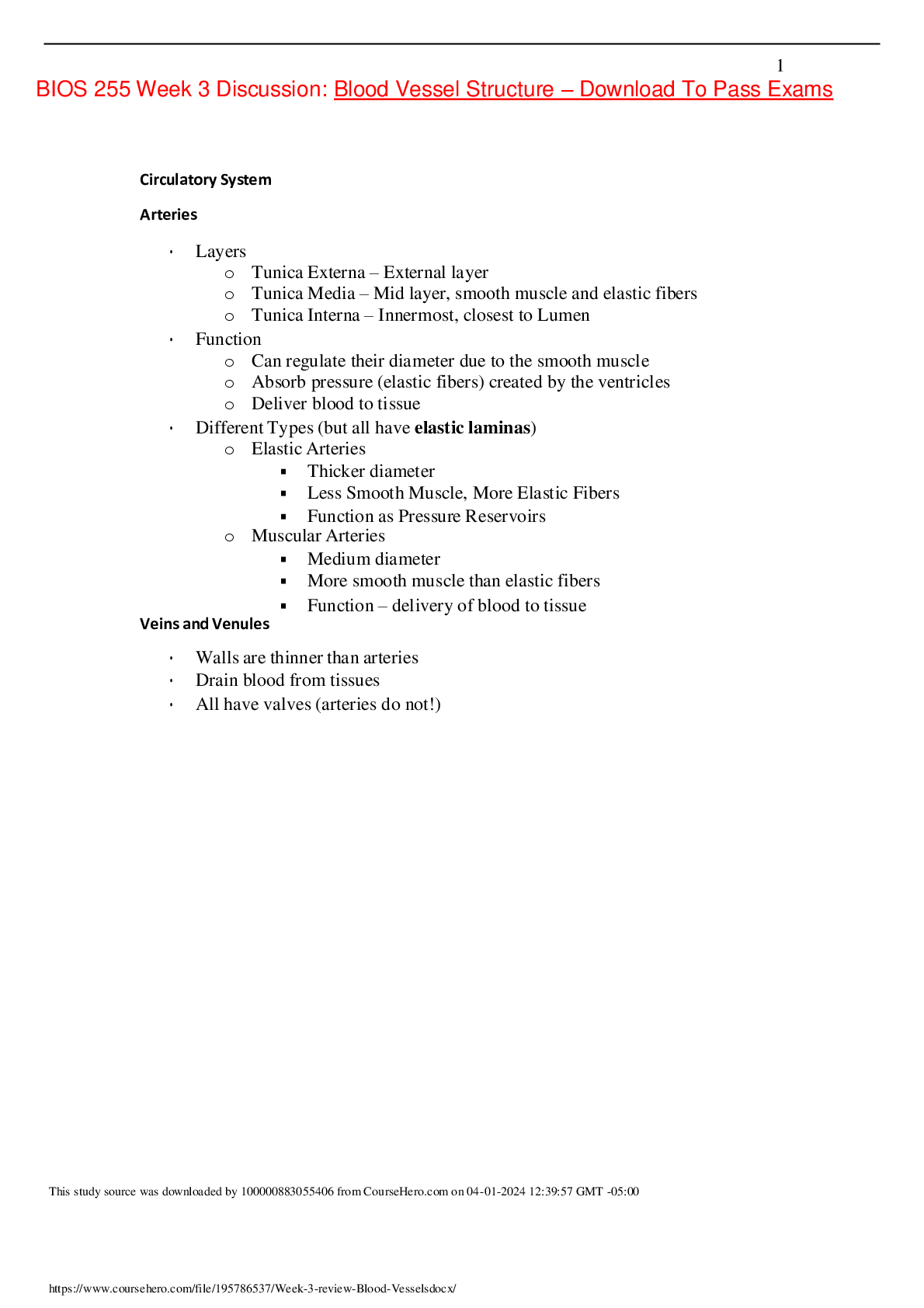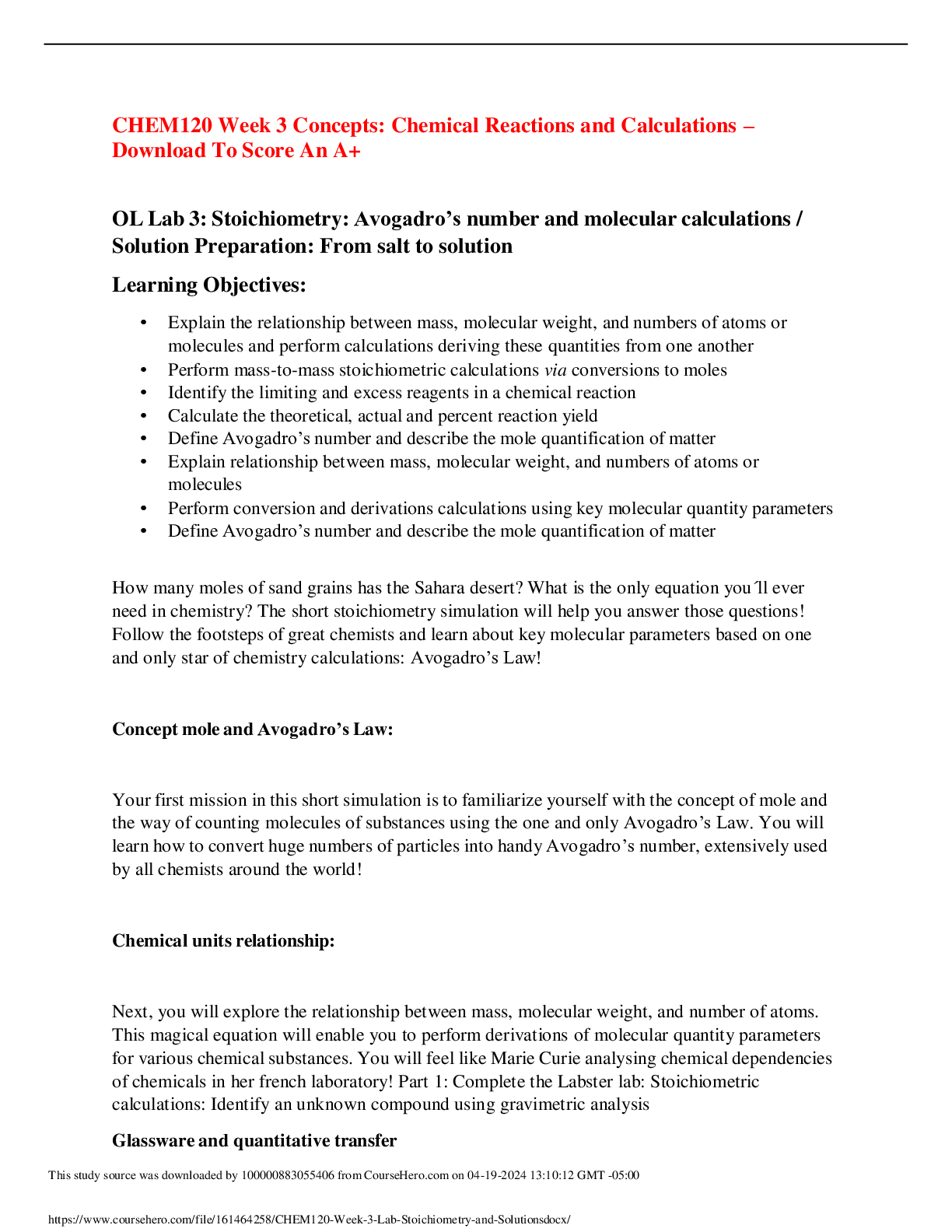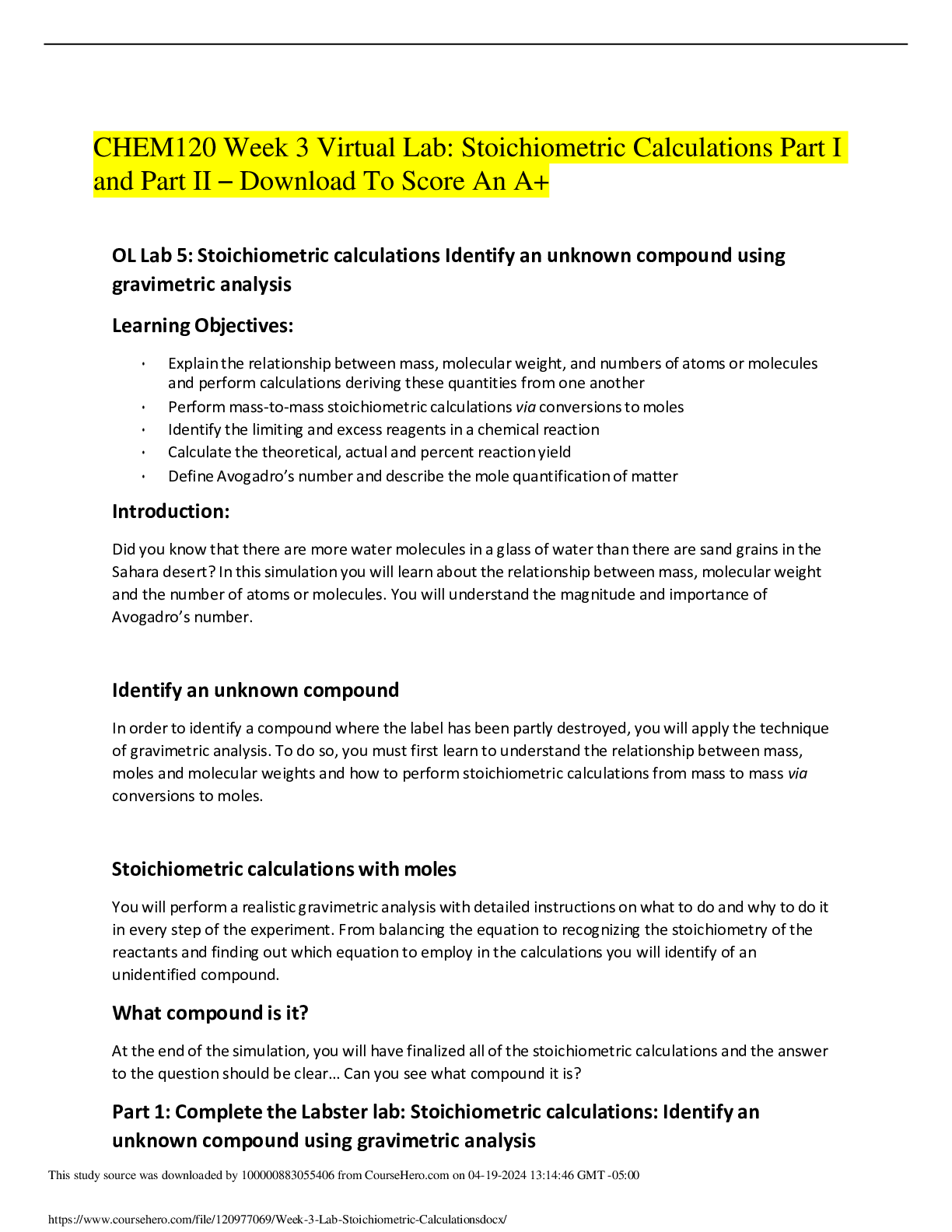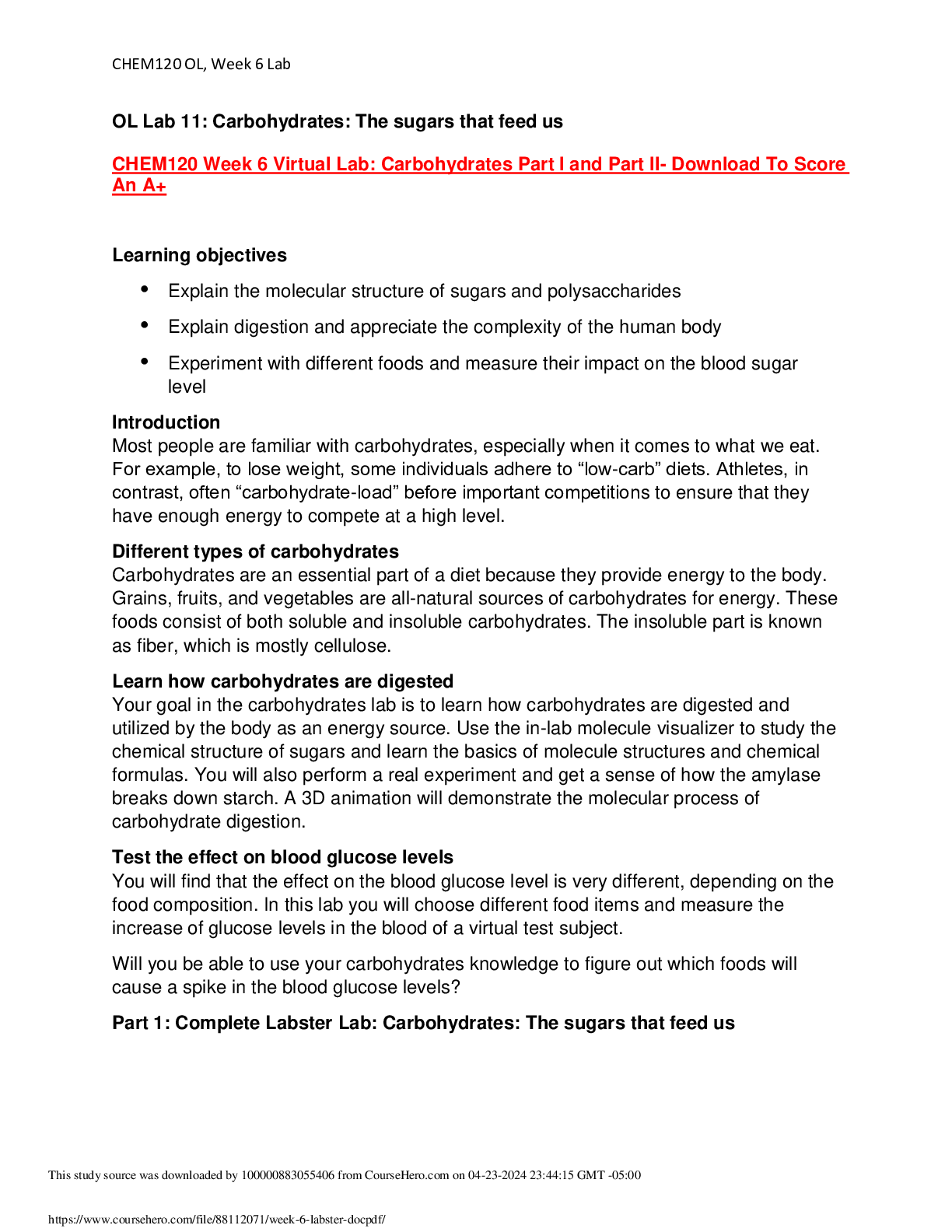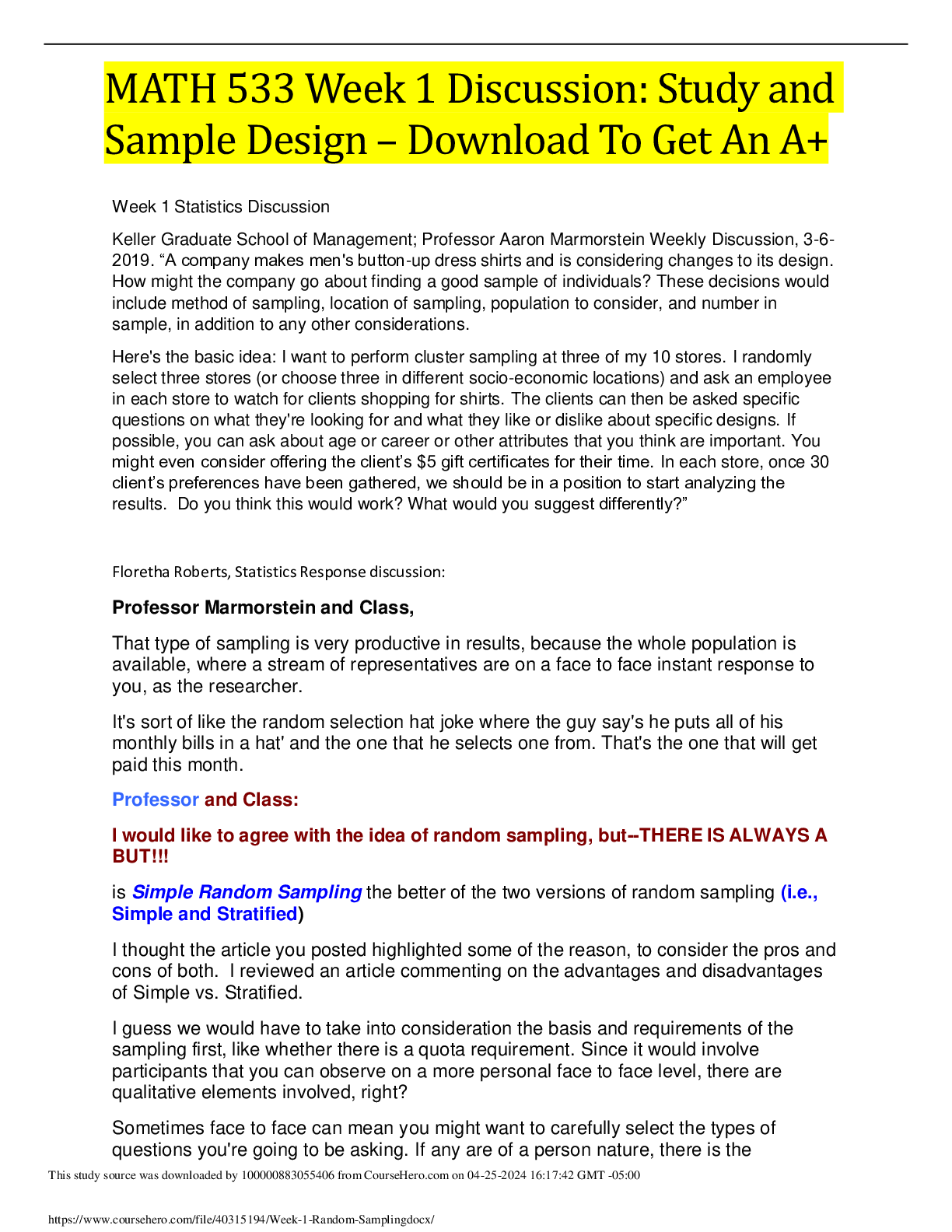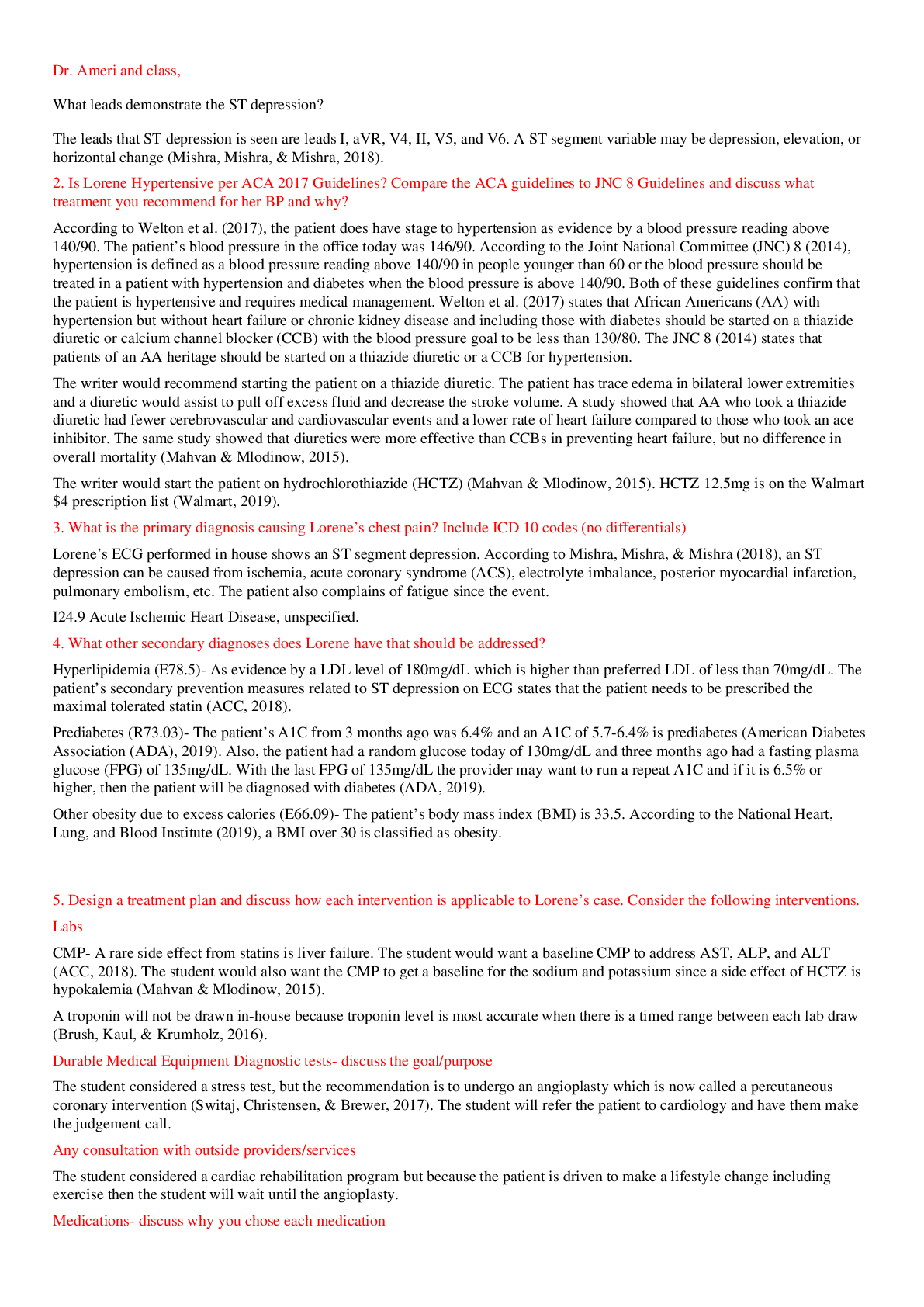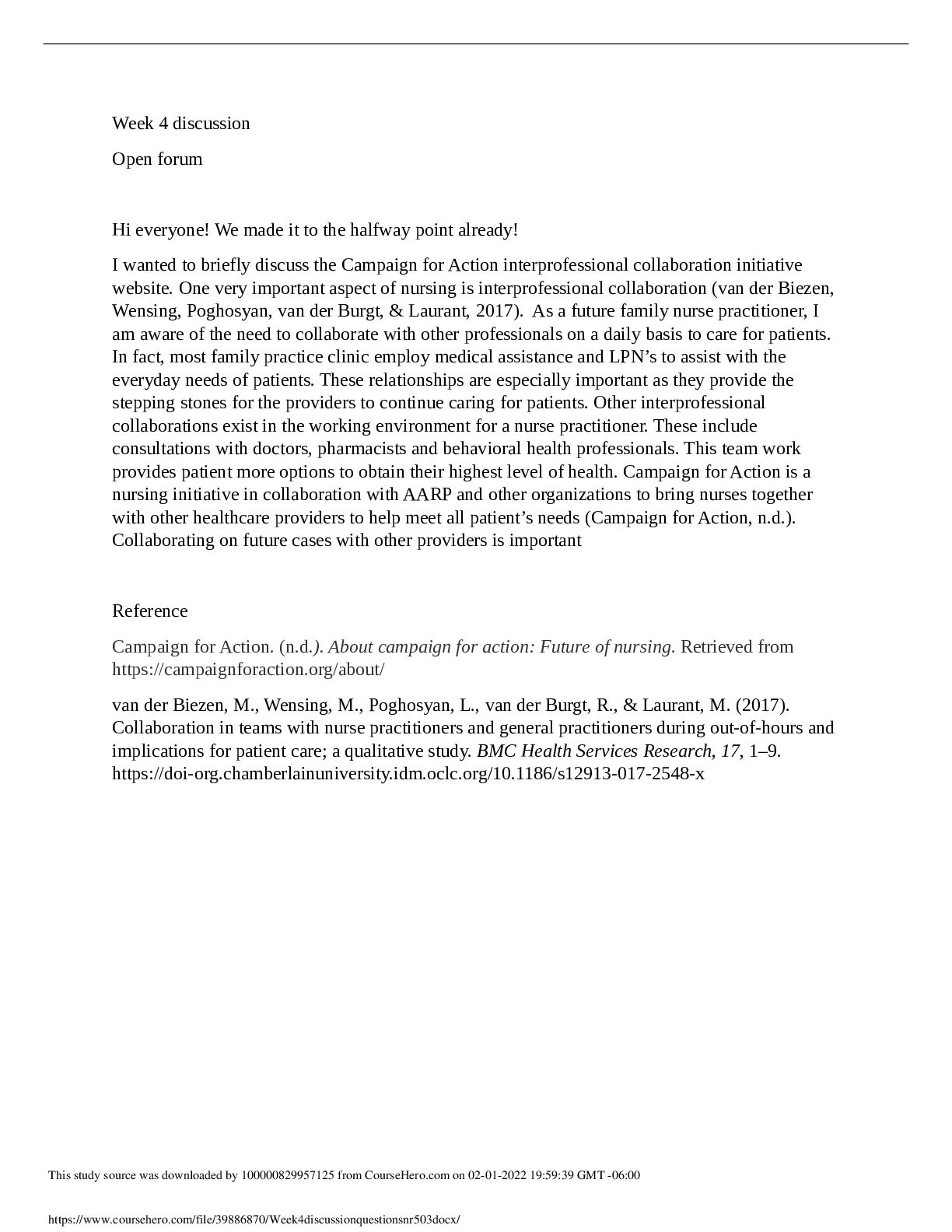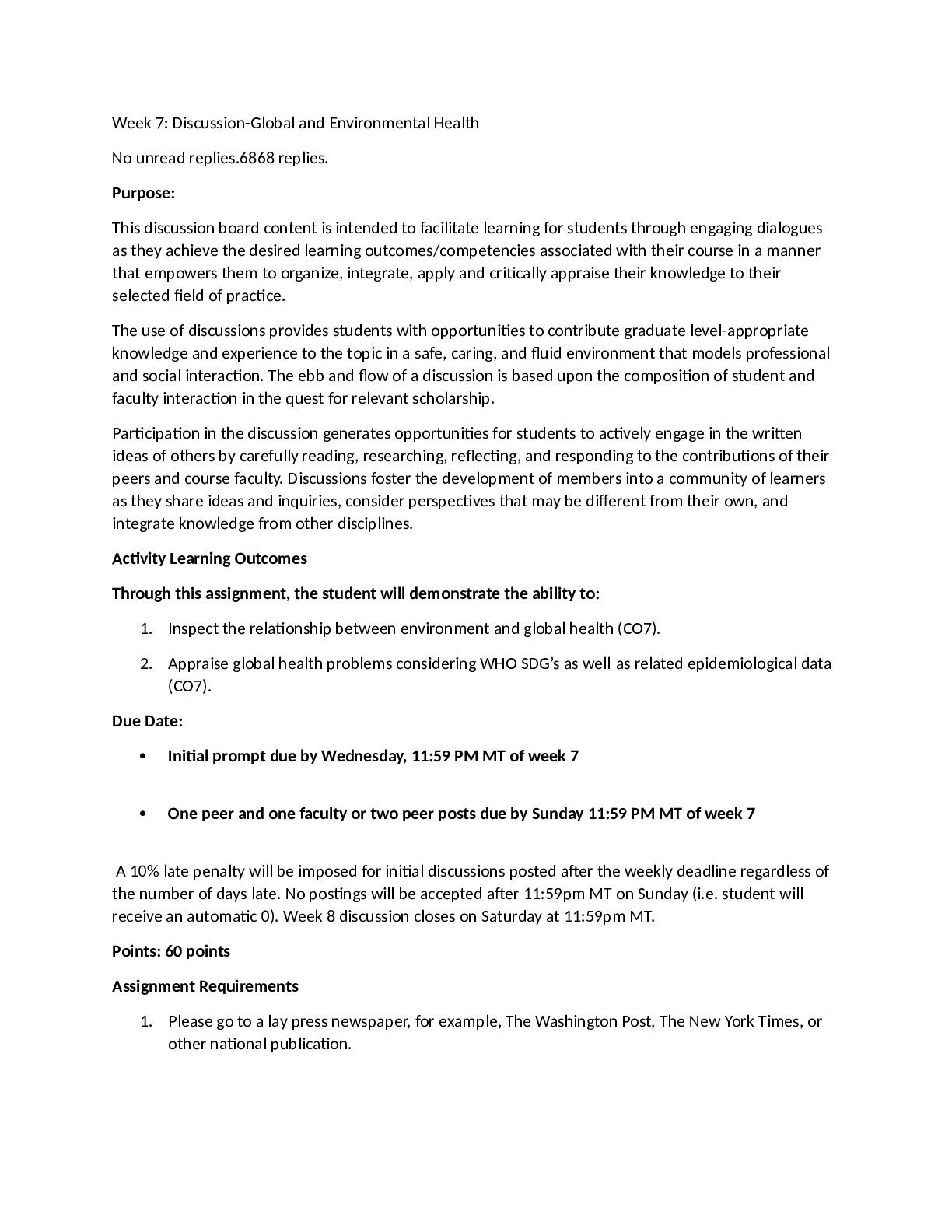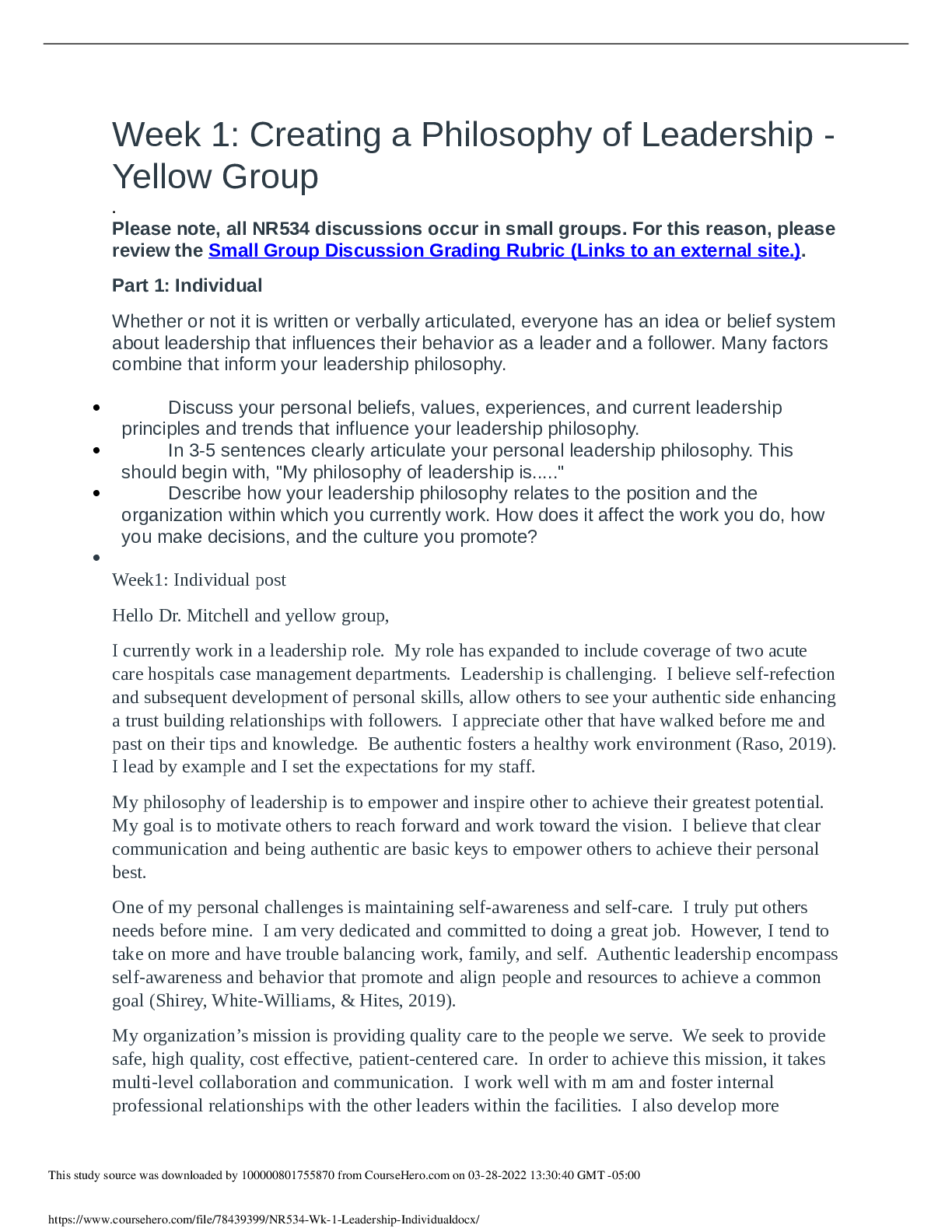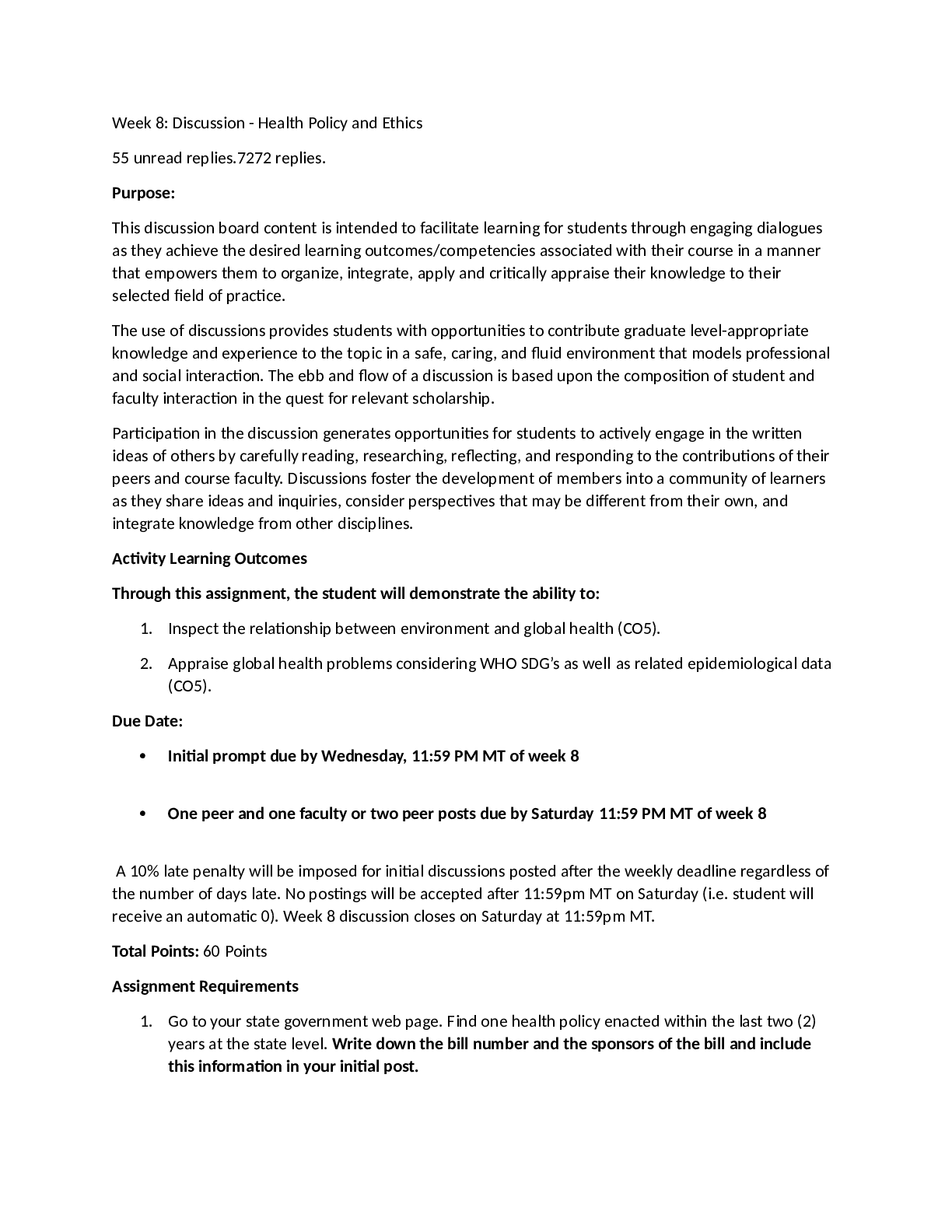Chemistry > DISCUSSION POST > CHEM120 Week 2 Concepts: Understanding the Structure and Naming of Molecules – Download To Score A (All)
CHEM120 Week 2 Concepts: Understanding the Structure and Naming of Molecules – Download To Score An A+
Document Content and Description Below
CHEM120 Week 2 Concepts: Understanding the Structure and Naming of Molecules – Download To Score An A+ Introduction Building on the fundamentals of covalent bonding, we will be looking deeper ... into the structures and behaviors of molecular compounds. We will be exploring how covalent bonding is involved in the structure of these molecules and determines how they interact with the world around them. What shape would you expect the compound Hydrogen Fluoride to have? o Pyramidal o Tetrahedral o Linear o Bent Which of the following substances would you not expect to dissolve in water? o Alcohol o Oil o Sugar o Salt COVALENT MOLECULES The way covalent molecules behave is strongly influenced by their structure. A major theme in chemistry overall is that structure greatly impacts properties. This structure/property relationships is why, for example, some liquids have a higher boiling point than others and why certain vitamins are easier to digest than others. To start out, we will be taking a deeper dive into Lewis Dot Structure and see how we can use skill to model the covalent bonding of simple molecular compounds and determine their shapes. Next, we will look at the concept of bond polarity. Finally, we will look at how shape and polarity of these molecules gives them the properties we observe in the real world. LEWIS DOT STRUCTURE FOR MOLECULAR COMPOUNDS Lewis dot structure is a helpful tool for determining the bonding properties of a nonmetal based molecular structure. As a quick reminder, molecular compounds form from non-metals and form covalent bonds. Each of these covalent bonds is made of two electrons, and multiple bonds can be formed between a pair of atoms to make what we call double and triple bonds. Let us consider how to show the Lewis Dot Structure of the molecule water: H2O. The first question we must ask ourselves is: How many unpaired valence electrons do each of these atoms have? H O Hydrogen atoms each have an oxygen atom has 1 unpaired valence electron. 2 unpaired valance electrons. Here are the Lewis dot structures of the three atoms in this structure. Since there are only two electrons possible in a single covalent bond, the unpaired electrons are the ones that will be most able to form bonds. H H O Now let us consider how we would connect these together. There are a series of quick steps to follow for simple compounds: 1. Place the atom that can make the most bonds in the middle O 2. Place the other atoms around the center atom, doing the best job possible of lining up unpaired electrons with each other. 3. Pair up the electrons by circling OR draw a line from one to the other to make a bond. 4. Repeat step 3 until all atoms have a full shell (8 for most atoms, 2 for hydrogen). Complete the sentence by filling in the blanks: Hydrogen atoms each have 2 unpaired valence electrons while an oxygen atom has 2 unpaired valence electrons. Between an atom of hydrogen and an atom of oxygen, which do you think could make more covalent bonds? o Hydrogen o Oxygen For each molecule think about which atom would go in the middle. Draw the Lewis Dot Structure, then advance the slides to see the correct structure. NH3 Which atom would go in the middle? Draw the Lewis Dot Structure. NH3 CH4 Which atom would go in the middle? Draw the Lewis Dot Structure. CH4 SF2 Which atom would go in the middle? Draw the Lewis Dot Structure. SF2 LEWIS DOT STRUCTURE: DOUBLE & TRIPLE BONDS Double and triple bonds are present in a wide variety of molecular compounds. To do this, we follow the same rules as before, noting that we may need more than one bond between each pair of atoms. Let us look at an example involving CF2O. • Place the atom that can make the most bonds in the middle. (This will be C as carbon has 4 unpaired valance electrons) • Place the other atoms around the center atom, doing the best job possible of lining up unpaired electrons with each other • Pair up the electrons by circling OR draw a line from one to the other to make a bond • Repeat step 3 until all atoms have a full shell (As we see here, this may take more than one bond between a pair of atoms) • Carbon is nearly always in the middle as making four bonds make this atom very versatile. You will study more about the versatility of carbon when you explore organic chemistry. Practice drawing simple Lewis dost structures for molecules containing double and triple bonds. CH2O Which atom would go in the middle? Draw the Lewis Dot Structure CH2O CO2 Which atom would go in the middle? Draw the Lewis Dot Structure. CO2 HCN Which atom would go in the middle? Draw the Lewis Dot Structure. HCN SHAPE The shape of covalent compounds is key to the properties of these compounds. The shape of a molecule determines, for example, if a molecule can pass through a cell membrane. The shape of the molecule, in conjunction with the polarity, also determines how a molecule will interact with other molecules. The driving force for these shapes is valence shell electron pair repulsion theory (VSPER). This theory explains that since charges that are both negative repel one another, and that bonds, being made of electrons, have a negative charge, the bonds will repel one another. The same is true for any electrons on an atom, they repel both other electrons and bonds. We can use this theory to create a flow chart. Determining the shape of a molecular compound is easy as long as we are able to draw a Lewis Dot structure and determine the answers to a couple of simple questions as seen in the flowchart. Let us use this flow chart to determine the shape of H2O from the Lewis Dot Structure. Using the flowchart: How many atoms are around the center atom? • There are two H atoms around the O atom. Be sure not to count the center atom when asking yourself this question. Now, are there any non-bonded electrons on the center atom? • There are four electrons on the oxygen atom that are not in bonds. These electrons push the electrons in the bonds away from them, causing a change in shape. From this, we see that the shape of the molecule would be considered bent. Choose the correct shape for each molecule: CO2 Linear NH3 Trigonal pyramidal H2S Bent CCl4 Tetrahedral PF3 Trigonal pyramidal POLARITY Covalent bonds are not all equal as not all nonmetals have the same affinity for electrons. When one of the atoms in a bond has a higher affinity for electrons than the other (called electronegativity), a polar covalent bond is formed, where electrons are shared unequally. When both nonmetals in a covalent bond have similar electron affinity, a nonpolar covalent bond is formed, where the electrons in the covalent bond are shared equally. As we can see in the image, elements tend to be more electronegative as we look from the bottom left to upper right of the periodic table (with the exception of the Nobel gasses, as they, being already stable, do not seek additional electrons). Fluorine is the most electronegative of the elements on the periodic table. If we think of the electrons being shared in a covalent bond as a rope in a tug-of-war, we can better understand the concept of polarity in covalent bonding. In this analogy, think of electronegativity as strength, with higher electronegativity indicating greater strength. In a covalent bond, the electrons will be closer to the atom with more “strength” just like in a tug-of-war. For example, consider the covalent bond between H and F in HF. As we can see here, the electrons in the bond will be pulled closer to the more electronegative (stronger) F atom. As electrons are negatively charged, this will give the F a slightly negative charge and the H a slightly positive charge. This charge difference is known as polarity, like in a magnet with a + and - end. These partial charges have delta (δ) symbol to indicate that this is not a full charge like we would see in an ion where an electron is gained or lost. Covalent bonds that have unequal sharing are known as polar covalent bonds, while covalent bonds that share electrons mostly equally are known as nonpolar bonds. While there is a scale to determine the exact classification of a covalent bond based on polarity difference, for the purposes of this class, we will consider the bond between two atoms of the same element to be nonpolar and between elements of different atoms to be polar. The exception to our rule will be that we will consider bonds between C and H to be nonpolar as the electronegativity difference is so small. Which of the atoms in each pair below would you expect to be more negative in a polar covalent bond? HCl Cl OP O NO O SeCl Cl FO F SCl Cl Select all molecules that you would expect to contain one or more polar covalent bonds. Select all that apply. o CF4 o NaF o CH4 o P2Br6 o O3 HYDROGEN BONDING An important consequence of polarity is the concept of hydrogen bonding. Hydrogen bonds, as the name implies, typically involve hydrogen. In a hydrogen bond, two molecules with polar covalent bonds, typically at least one having a hydrogen, interact with each other as pictured here. The attraction between the partial positive charge of the hydrogen and partial negative charge of the fluorine in two HF molecules is what generates the hydrogen bond in the image above. This attraction is a type of intermolecular (between molecules) interaction. It is important to note that this attractive force, while being the strongest intermolecular force, is not as strong as the intramolecular (within atom) forces that hold atoms together. Hydrogen bonding also helps to explain why water (H2O) is a liquid at room temperature while nitrogen (N2) is a gas at room temperature. View the illustrations of the interactions between molecules of each of these molecules. Hydrogen bonding is an important interaction in our bodies. For example, these are the bonds that hold together our DNA into the double helix shape. Additionally, these types of bonds are key to protein folding. These bonds are also largely responsible for shaping our proteins, as well as the function of antibodies. Hydrogen bonding is also why ionic compounds dissolve so well in water. Why is this? Ionic Compounds are made of positively charged cations and negatively charged anions. In water, both can be surrounded by the partial charges of the water molecules. This is the way the polar molecule water is great at dissolving other polar substances. Which of the molecules below would you expect to participate in hydrogen bonding? o H2S o CH4 o NH3 o HCl Electron areas such as bonds and unpaired electrons will repel one another, resulting in the shapes. CF4= Tetrahedral PCl3= Trigonal pyramidal CH2S= Trigonal planar CO2= Linear SeF2= Bent Select all molecules that you would expect to contain one or more polar covalent bonds. o BrF o CF4 o S8 o CaCl2 o N2O4 In which of the following molecules would you expect to contain nonpolar bonds. Select all that apply o HF o N2 o S8 o H2S The double helix structure of or DNA is held together by o Covalent bonds o Ionic bonds o Metal to metal bonds o Hydrogen bonds [Show More]
Last updated: 1 week ago
Preview 1 out of 10 pages
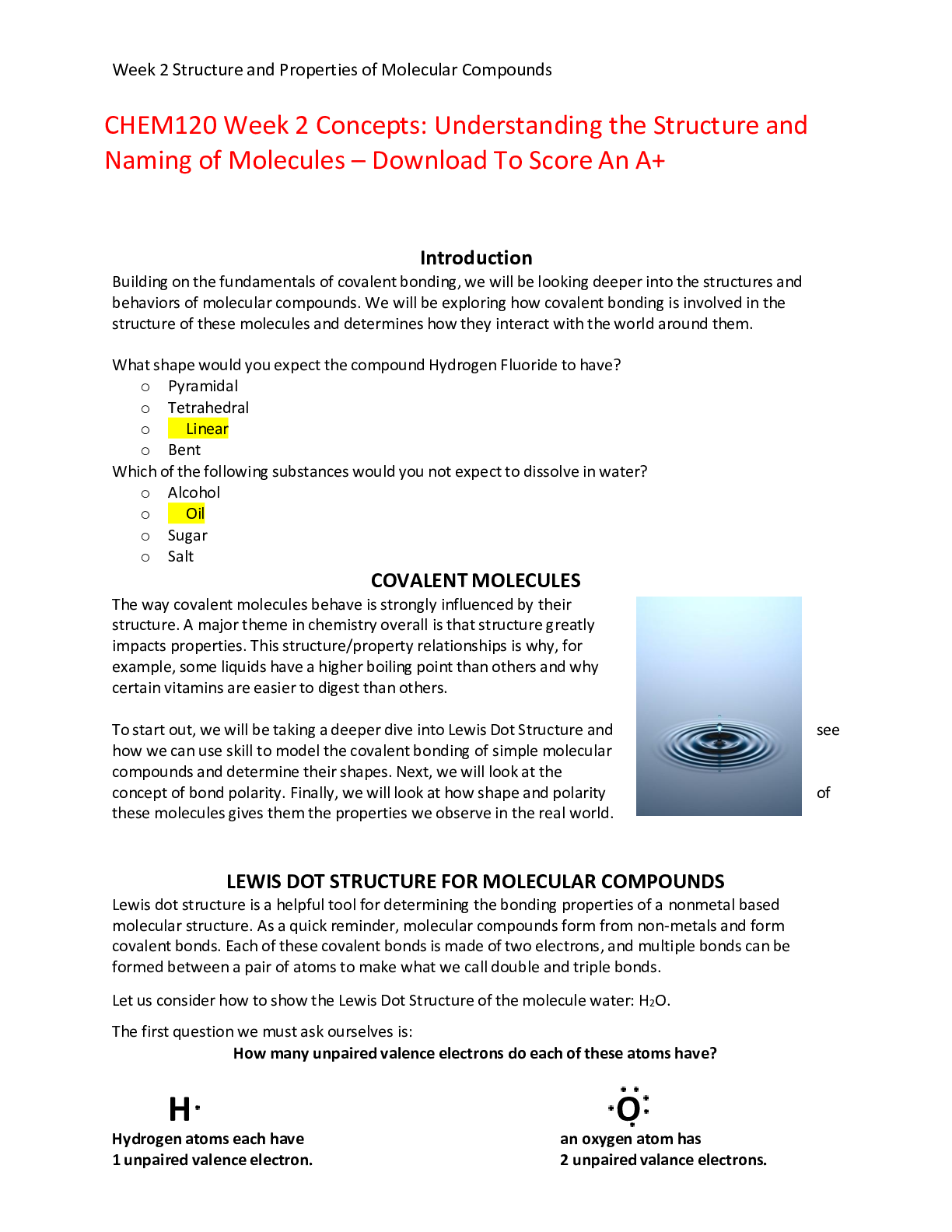
Reviews( 0 )
Document information
Connected school, study & course
About the document
Uploaded On
Apr 19, 2024
Number of pages
10
Written in
Additional information
This document has been written for:
Uploaded
Apr 19, 2024
Downloads
0
Views
5

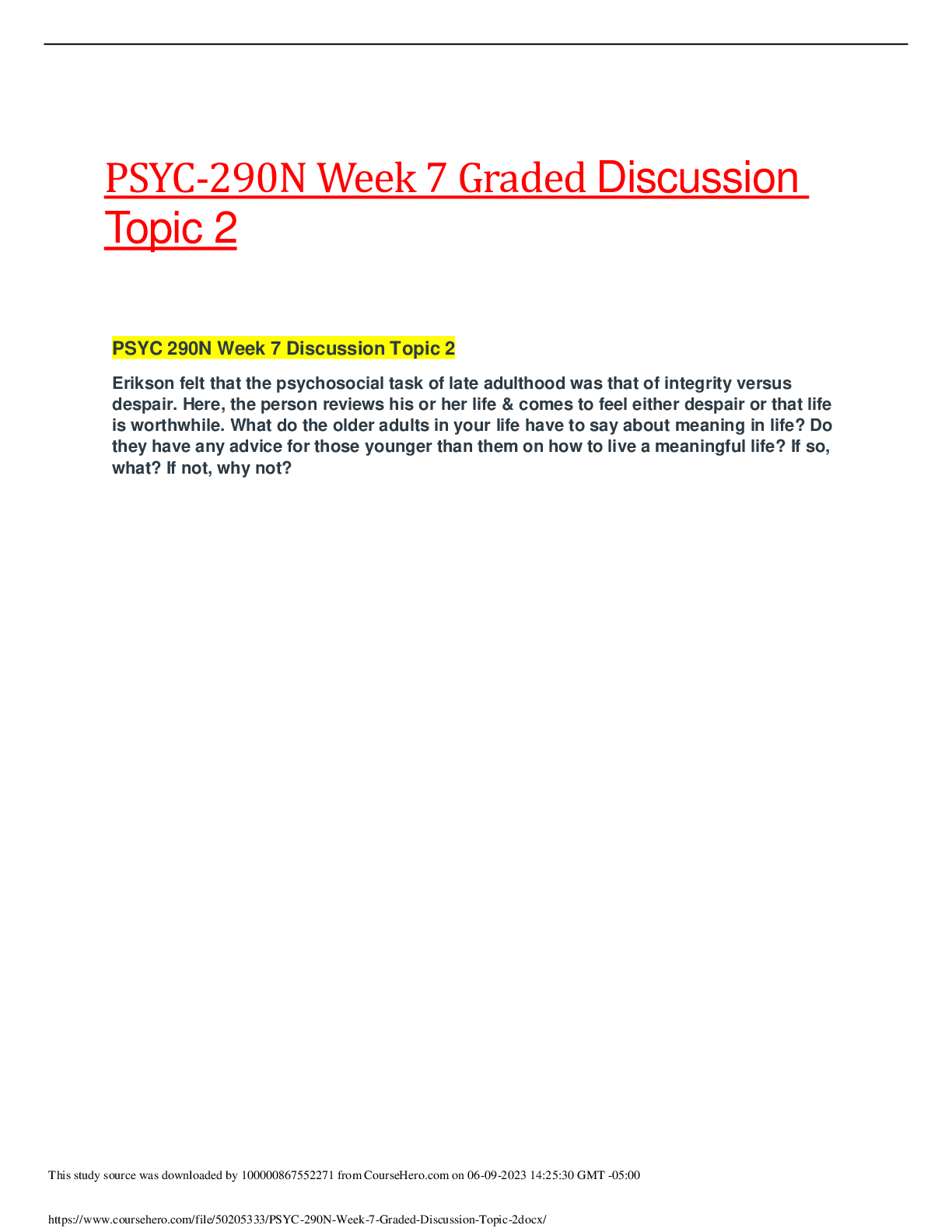
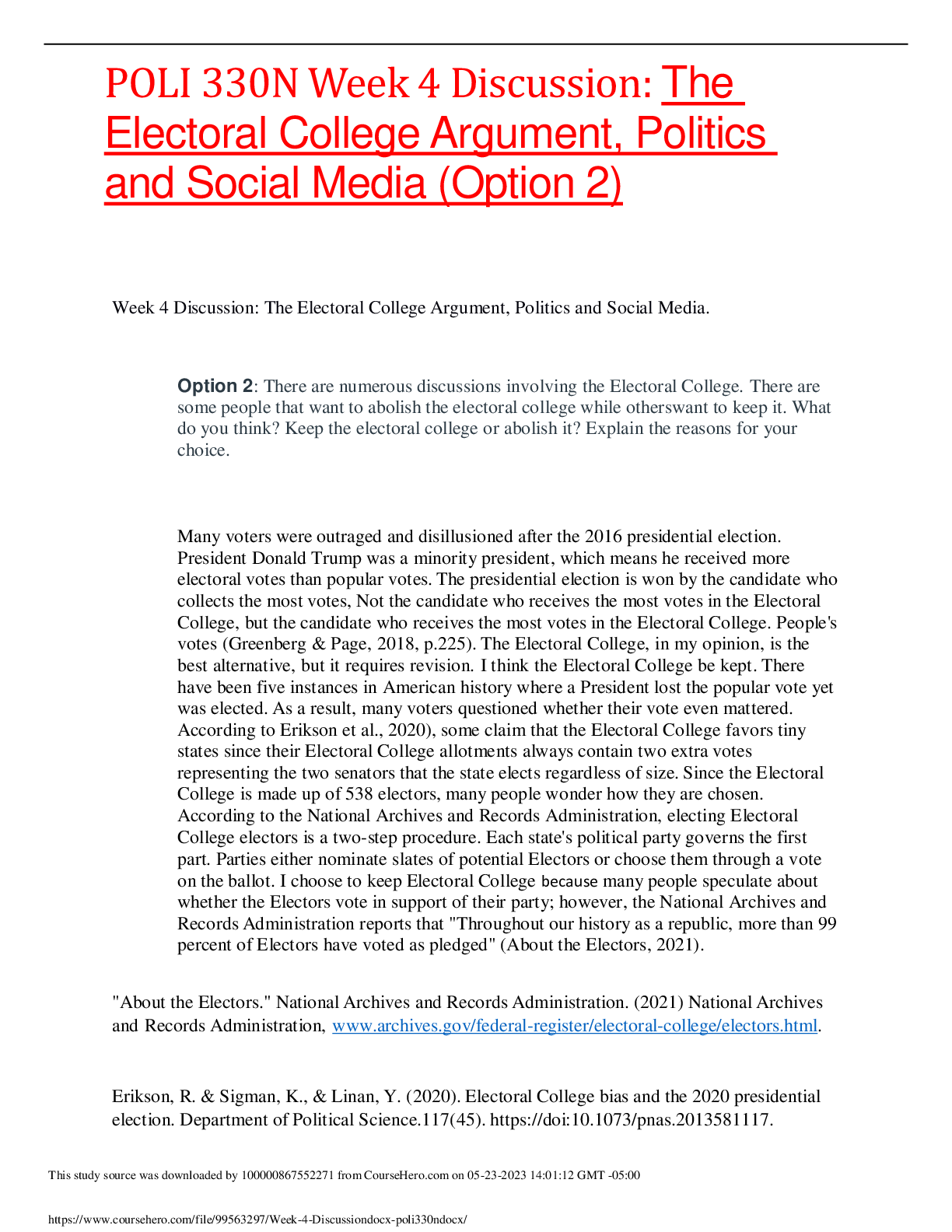
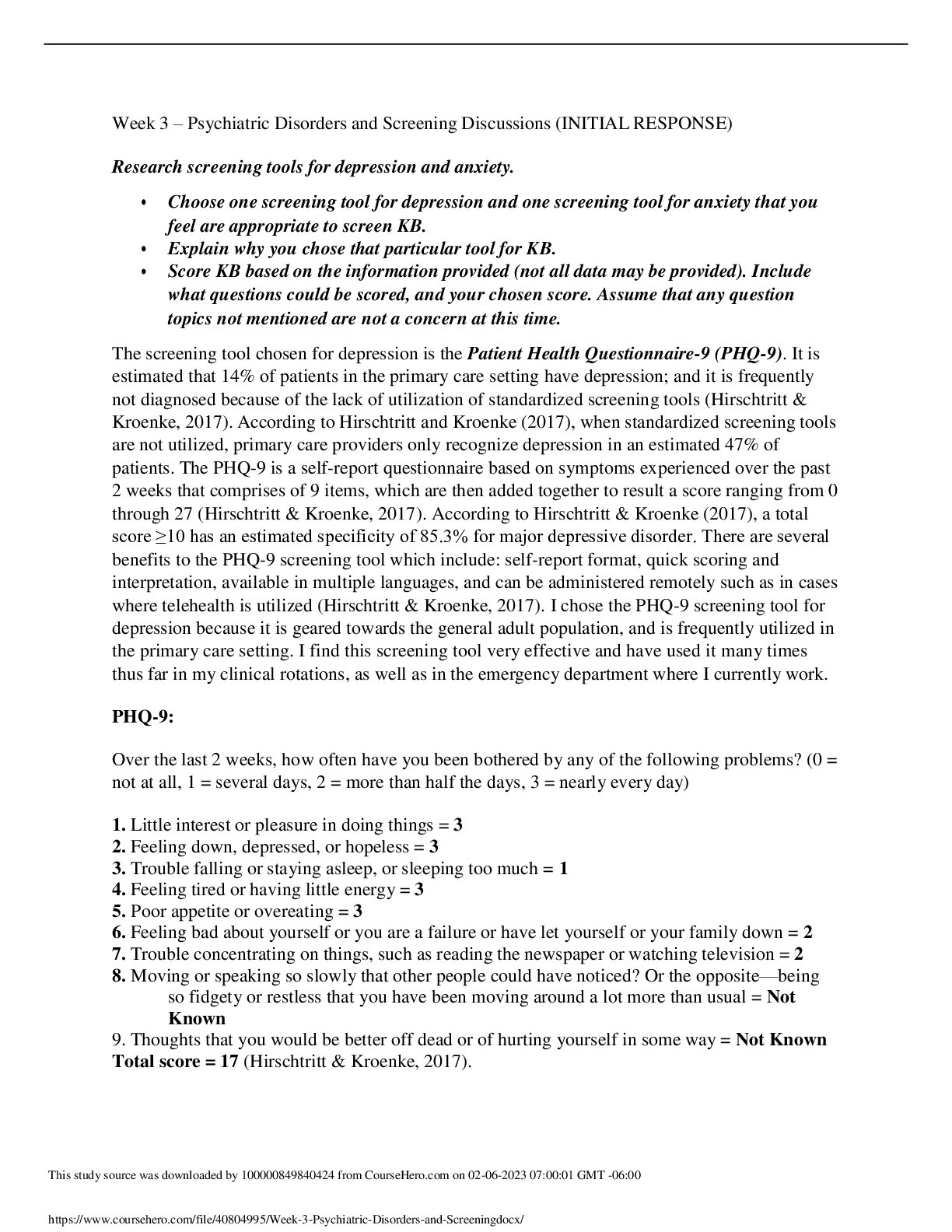
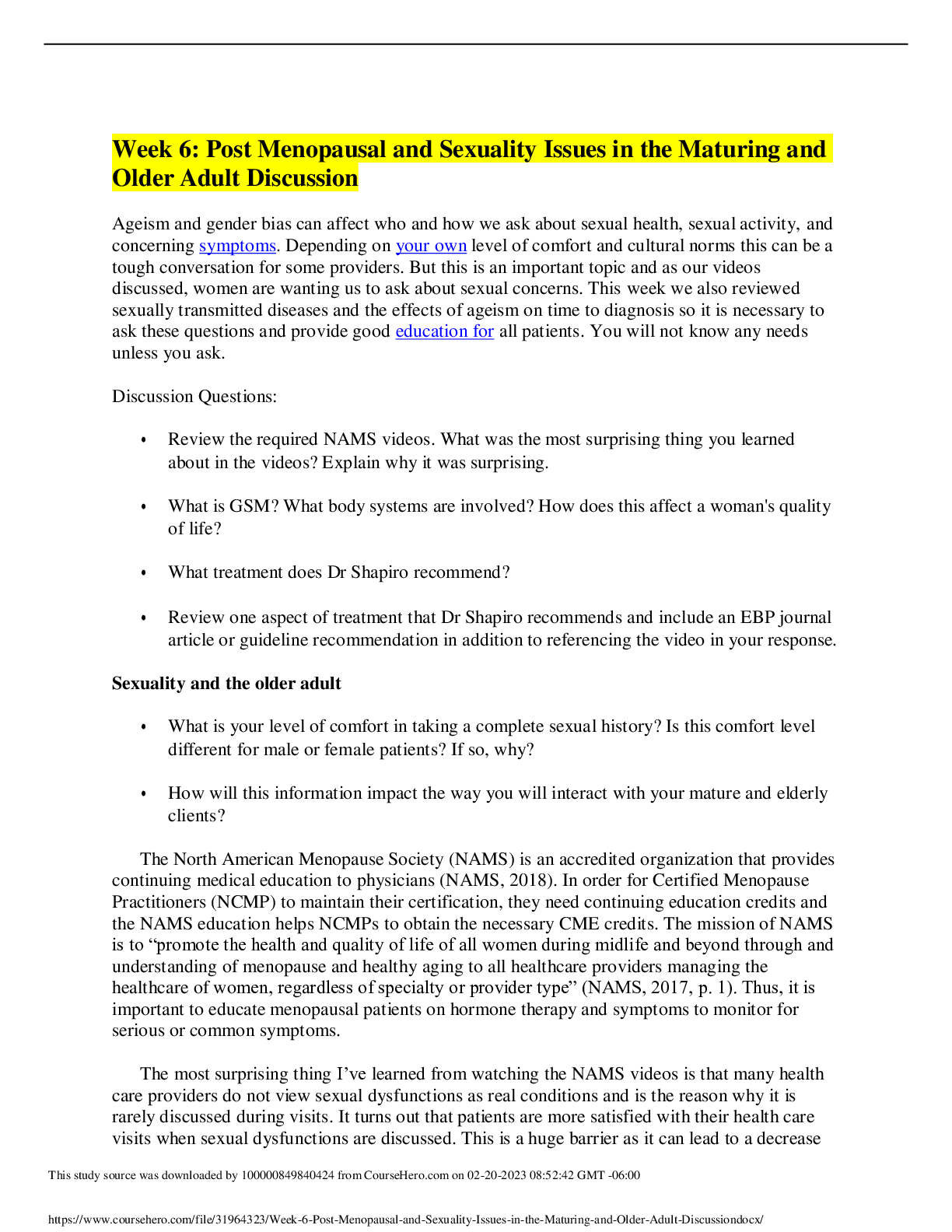
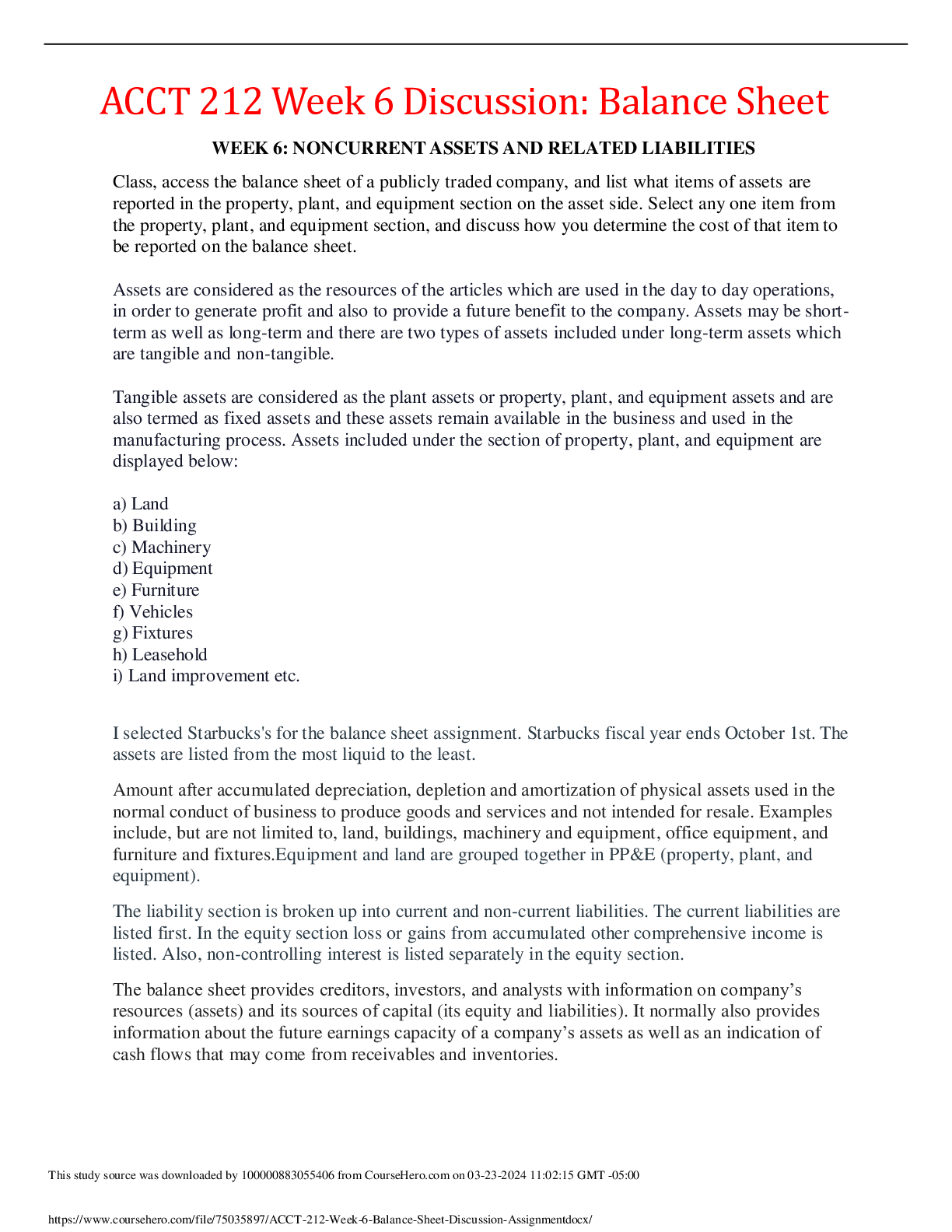
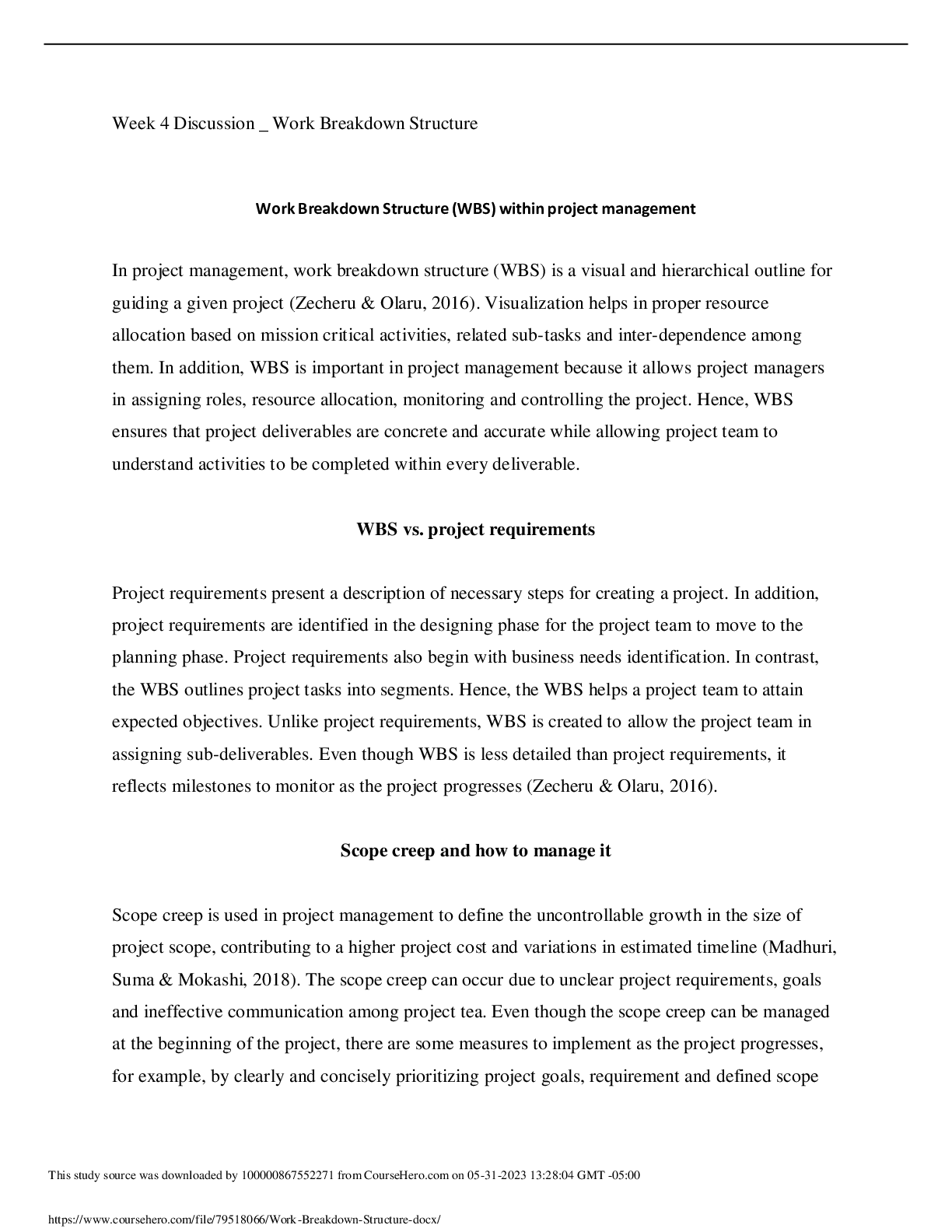

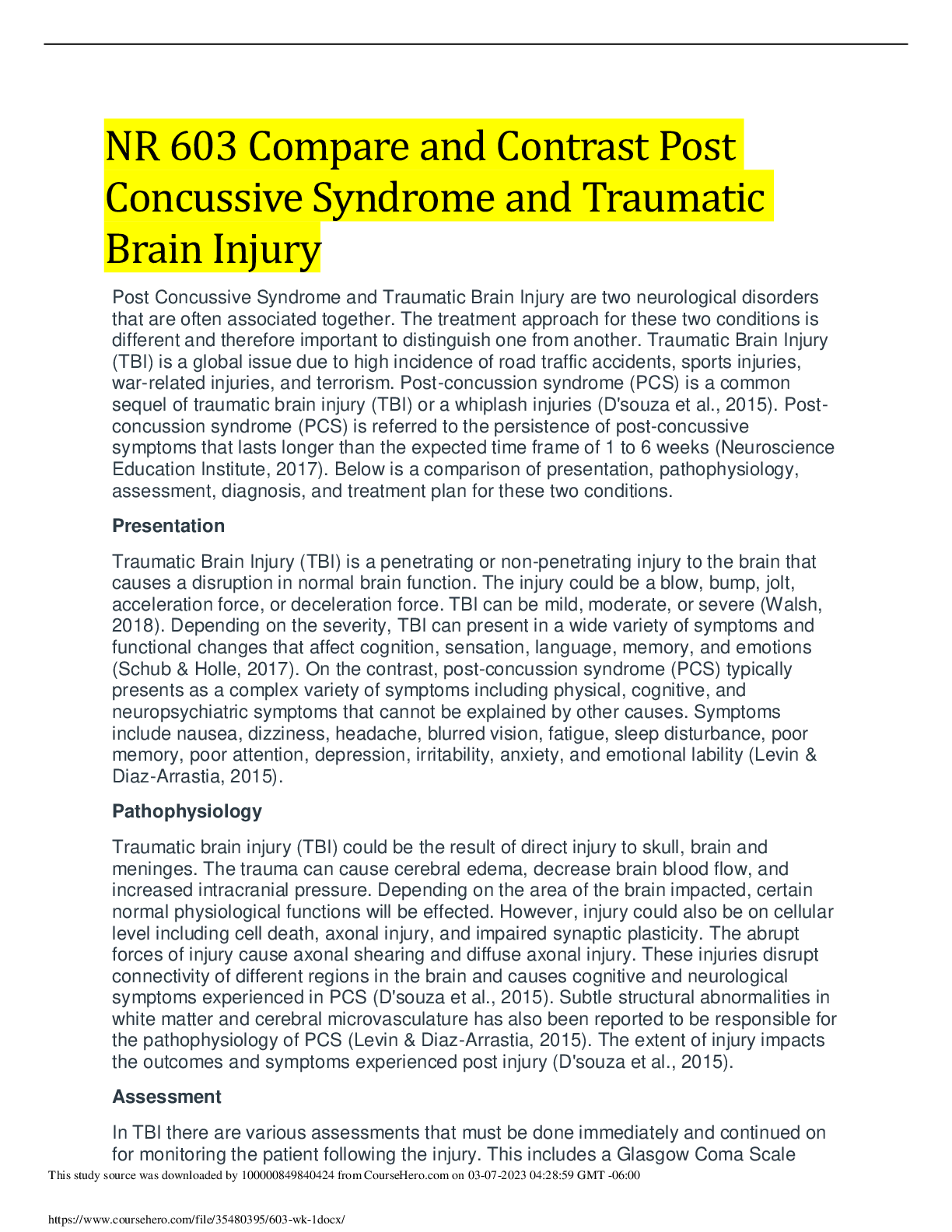

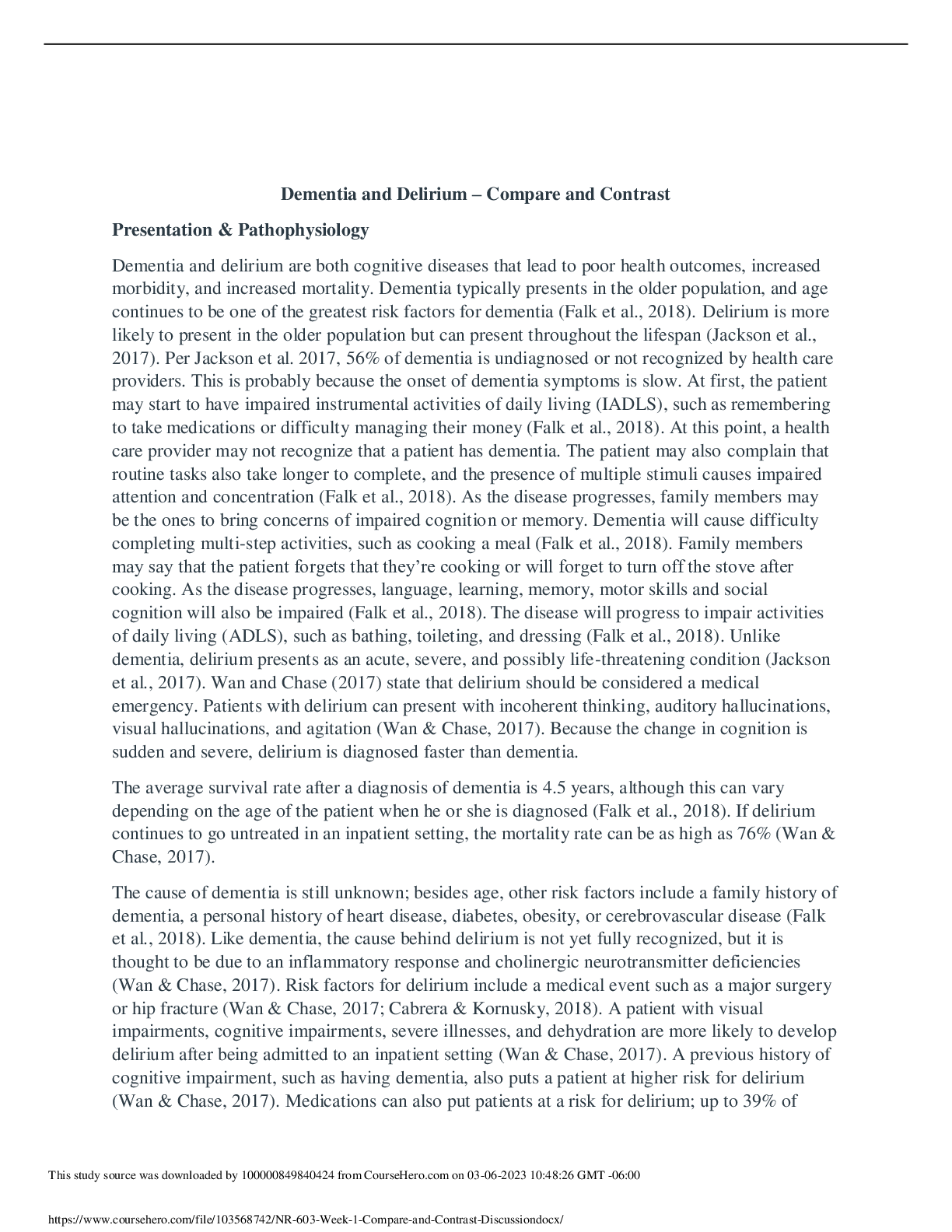

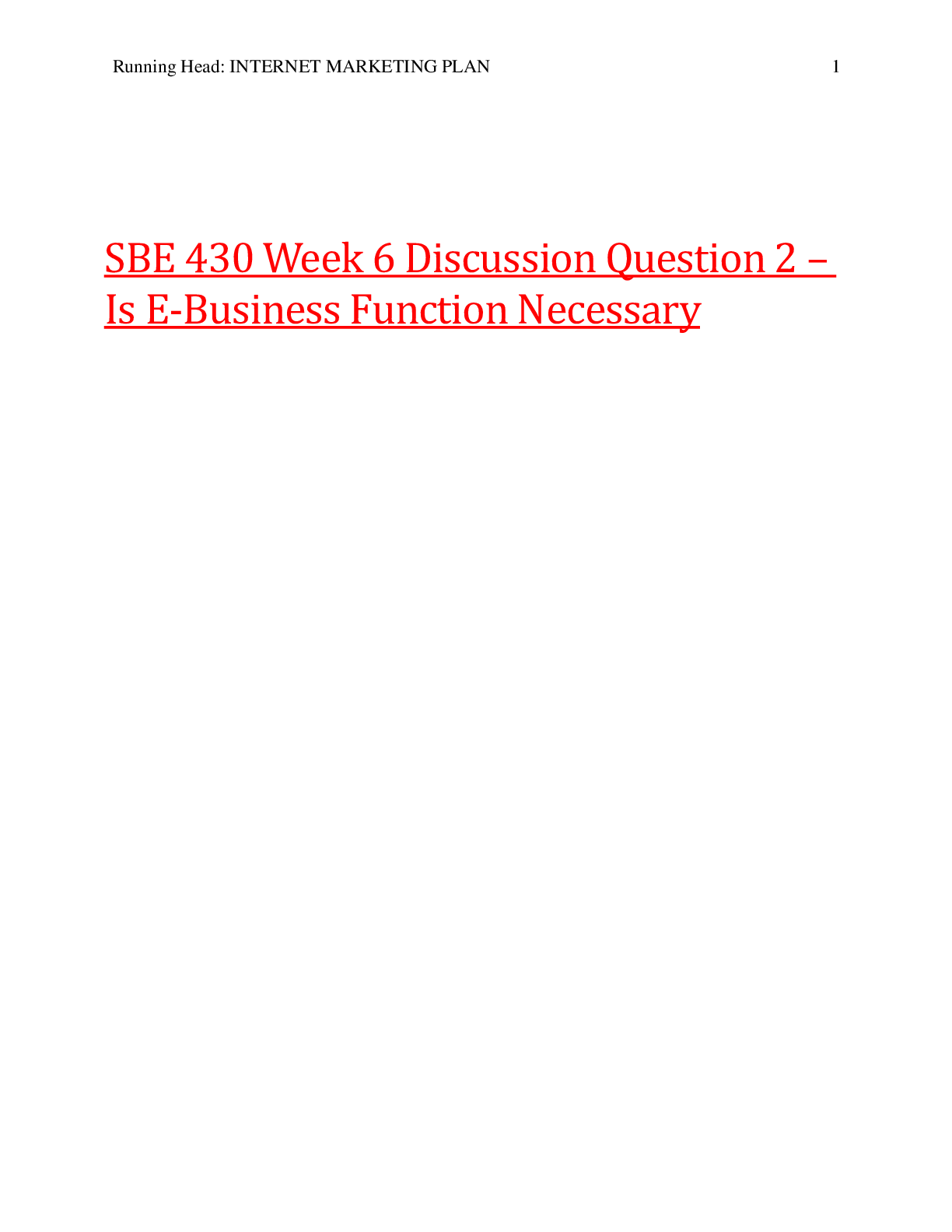
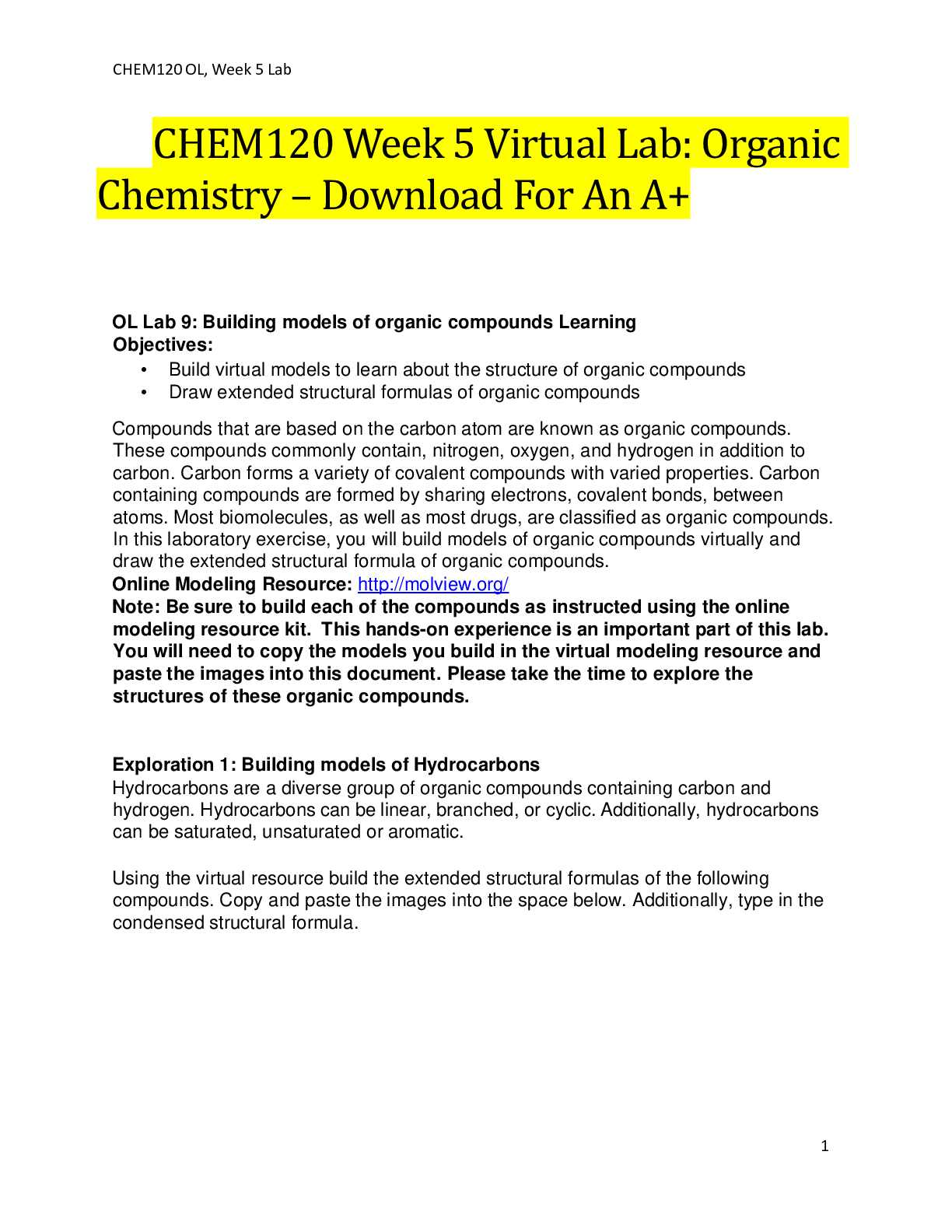
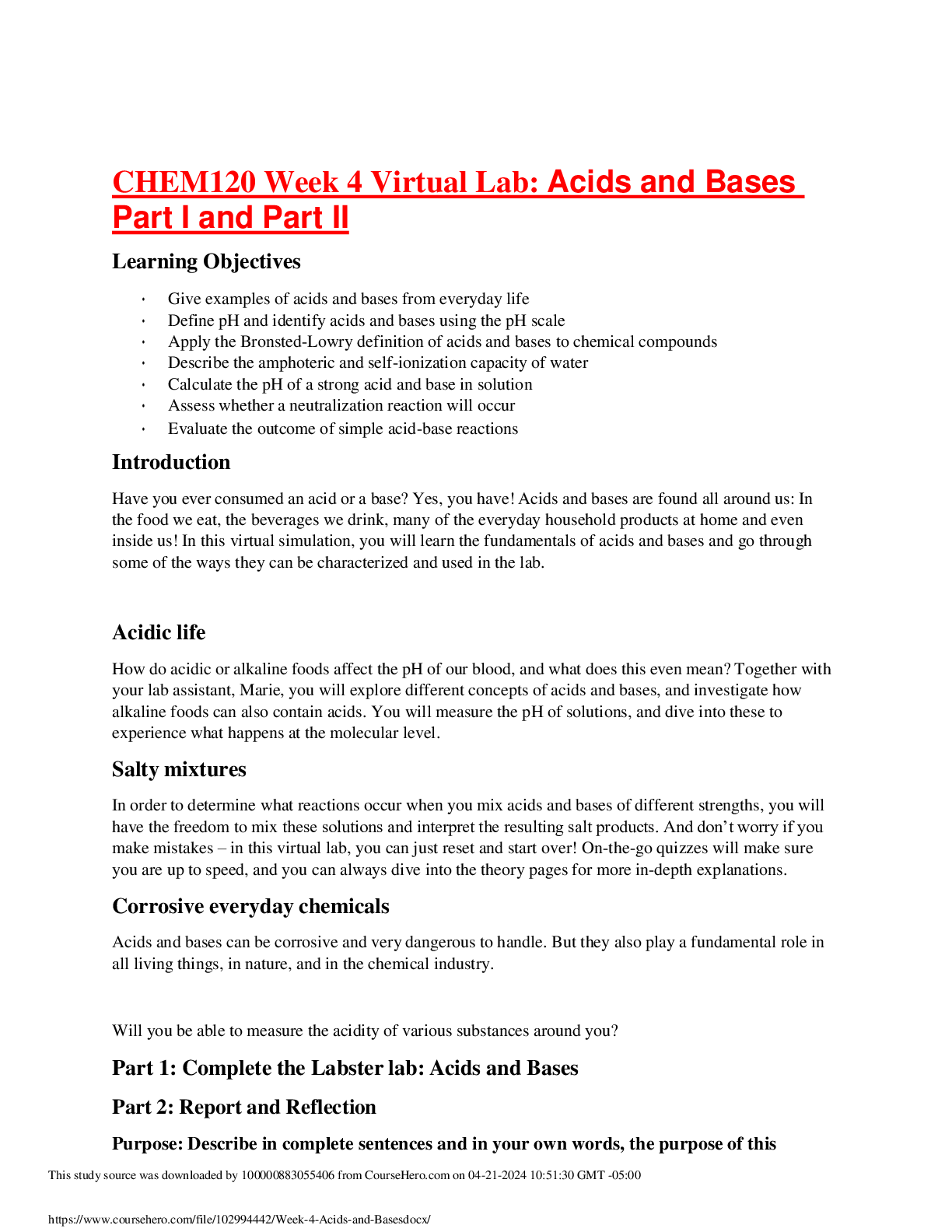
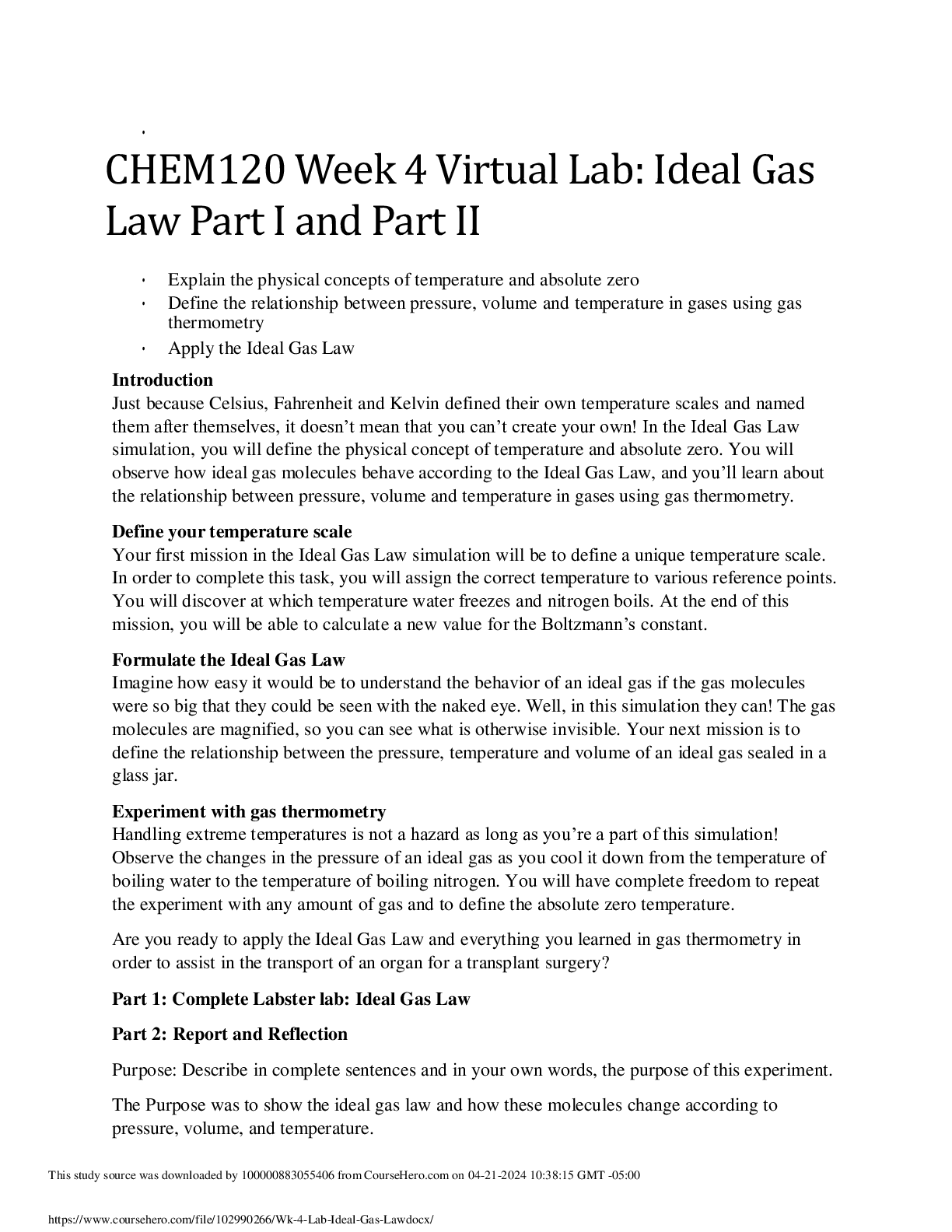
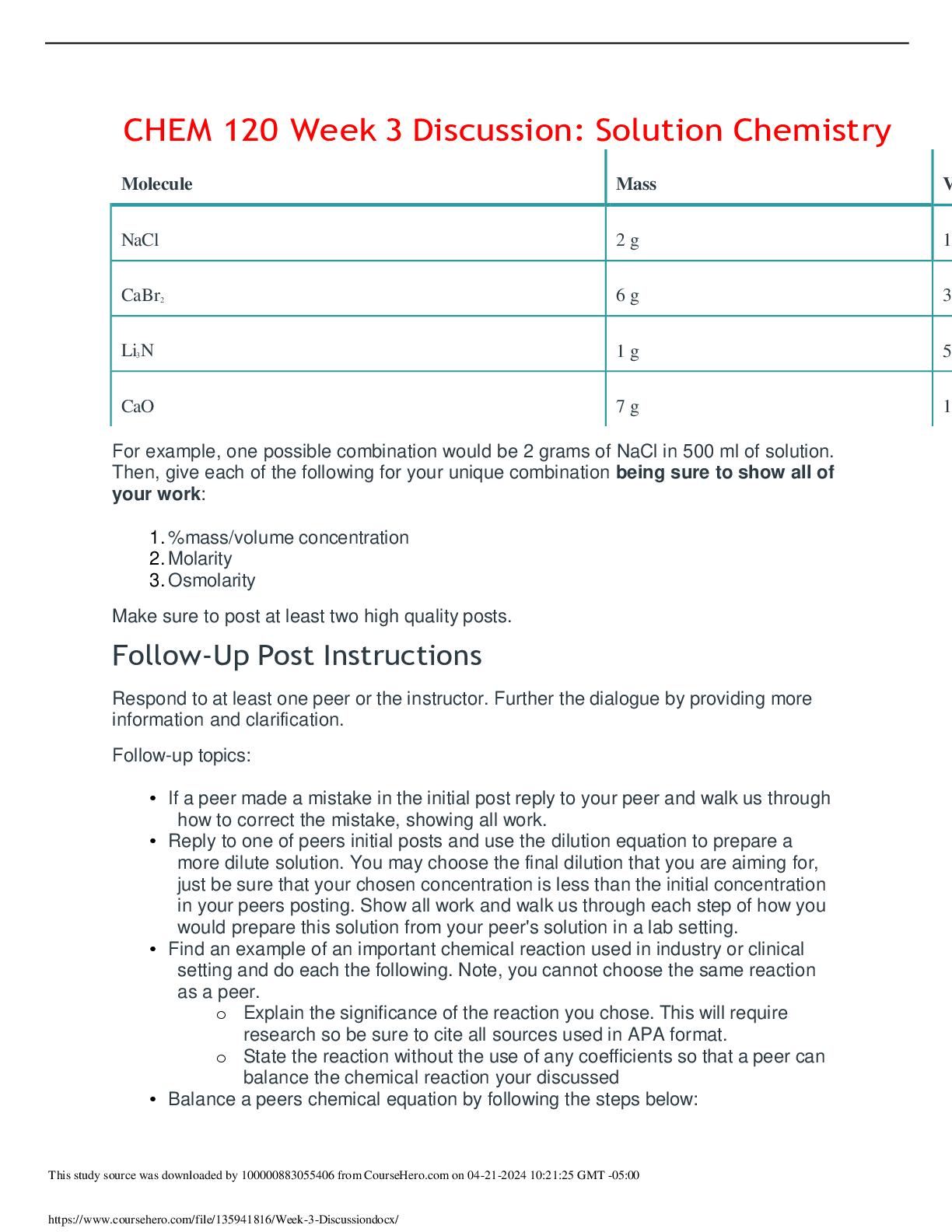
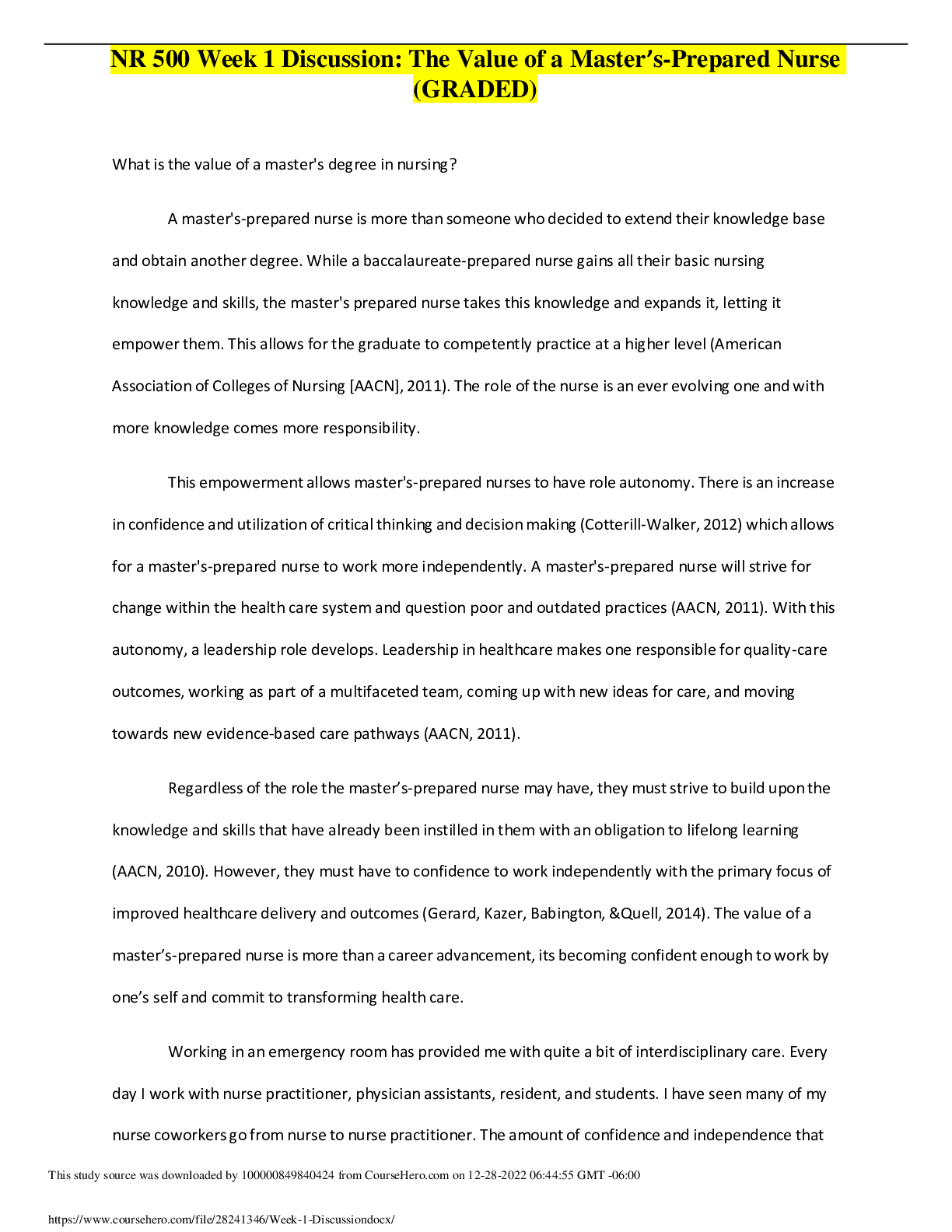
.png)
